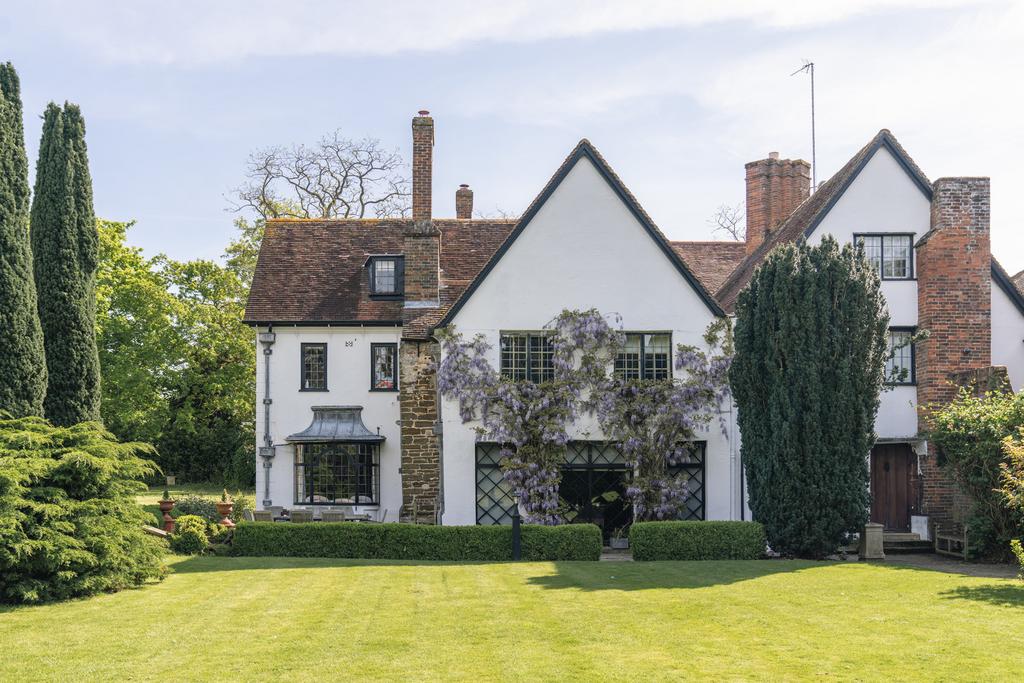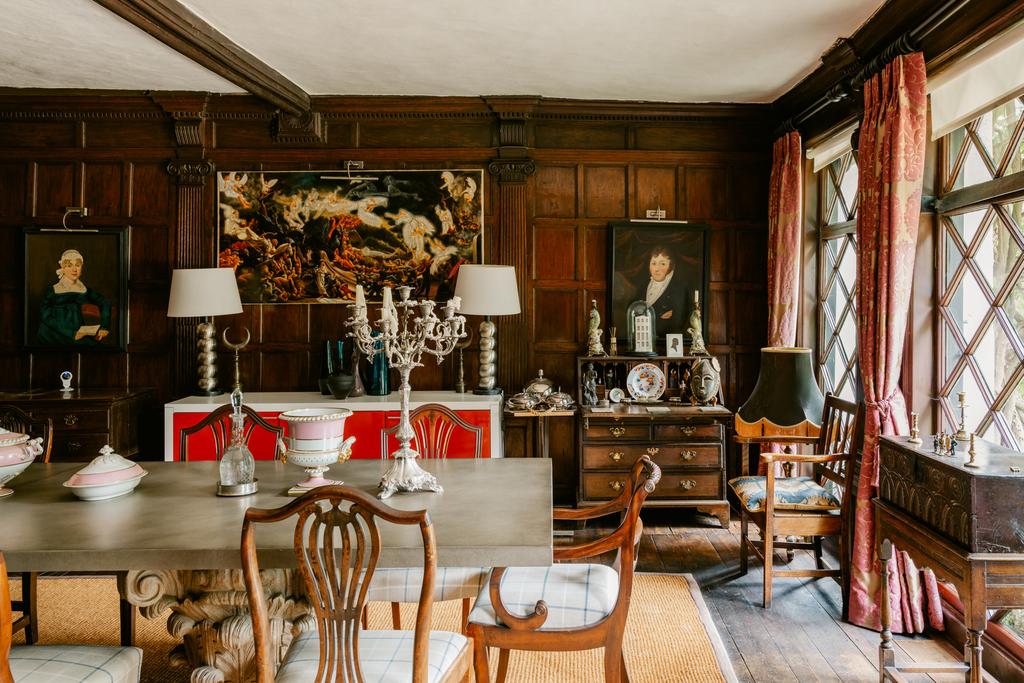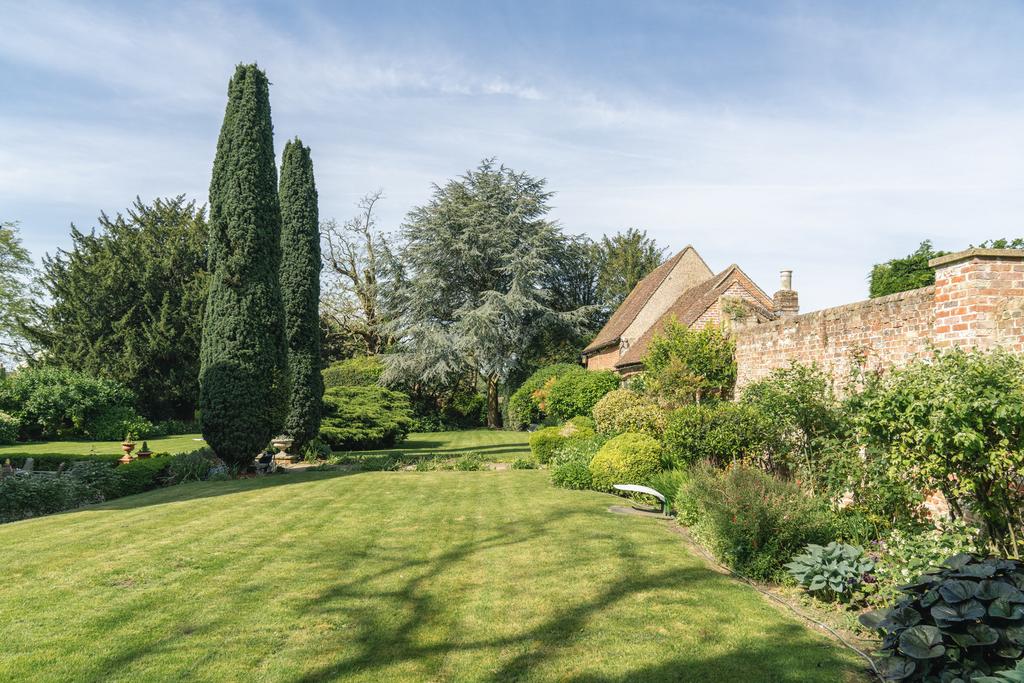


10 bedroom detached house for sale
Key information
Property description & features
- Tenure: Freehold
Setting the Scene
The original manor was extended in the late 1590s and again in the early 17th and 19th centuries. In the late 1930s, architect Sir Albert Richardson, designer of the Manchester Opera House and responsible for some works to Somerset House, also made some changes. The current owner, fascinated by the house’s history, has gathered much information from local archives, including some historical images.
The manor’s various extensions and remodels have left the house packed with rare original features, such as four-centred Tudor fireplaces, moulded beams and a Tudor foliate boss, and some early 17th-century panelling. In one of the original entrances, the owner removed some more contemporary plasterwork to reveal the house’s original wattle and daub construction, which is now protected by a glass panel. For more information, please see the History section.
The Grand Tour
A wide driveway with parking for numerous cars, including electric charging points, sits on one side of wrought-iron gates, which open onto the garden and a series of outbuildings. The Manor has three main entrances, and the formal entrance opens into a vast reception hall in the older part of the house.
The less formal entrance is on the south side of the manor. Constructed as part of the 1815 extension, it now houses three useful utility rooms serving the adjacent kitchen. The kitchen is composed of off-white cabinetry set against a granite worktop and has characterful terracotta tiles on the floor; original beams and iron hooks crown the room. From here, a door opens into a wide hall, which is also home to a downstairs WC and an area which could double-up as a study. The stone floors have a wonderful patina, developed over years of footfall.
In the oldest part of the house, thought to be 14th century, there is a room currently used as an office and an informal snug area. With lower ceiling heights, elm beams and mullioned windows, this is a cosier space.
A further series of rooms lead off the entrance hall. Firstly, the drawing room, which remains Georgian in style, with large sash windows framed by original shutters and narrow white-painted floorboards. Painted light blue, the room is wonderfully bright. A mantlepiece, dating from circa 1720, is found to one side. This room would have originally been the grand entrance, but in circa 1820, the front door was replaced by floor-to-ceiling sash windows in a bid to make the house more symmetrical, as was the fashion of the era.
Beyond is a wood-panelled family room with an ornate fireplace bearing the Victorian coat of arms dating from 1881. This, in turn, leads into the dining room, with a plethora of original features, from the Tudor beams, rose, fireplace and slightly later Jacobean panelling with decorative carved engaged ionic columns and dentils. This panelling reflects the candlelight and is a wonderfully atmospheric backdrop for celebrations and dinners, particularly in the winter. On the western end of the house, an extension built in 1937 houses another sitting room. It has large curved windows, a wall lined with bookshelves, and another warming fire.
Upstairs the house can be separated into two parts. Four bedrooms are in the 16th-century wing, one with soaring, vaulted ceilings and exposed beams. In another room – where Charles II is said to have stayed briefly – the 17th-century style prevails with red wallpaper, original dark wood panelling and matching floorboards. A second bedroom has similar panelling repurposed from other parts of the house and painted white. Two further rooms lie at the opposite side of the plan.
On the other side of the house are four bedrooms and three generous bathrooms. The second floor is home to loft space and two further guest bedrooms.
The Great Outdoors
The gardens and grounds have been carefully landscaped and feel private and secluded. A path leads between two mature cypress trees giving the garden a Mediterranean feel. There is a sheltered paved area, perfect for outdoor dining.
A fantastic range of period brick and timber outbuildings can be found on the grounds, including a recently renovated barn converted into two separate one-bedroom annexes.
Out and About
The house is located in the heart of the pretty village of Harlington, very close to the village green. Harlington has two traditional pubs, a doctors’ surgery, a newsagent, a post office and a general store with a café and a deli. The Chiltern Hills Area of Outstanding Natural Beauty is also nearby for great walks.
There are some brilliant state, private and grammar schools nearby, including in Milton Keynes, Bedford and Harpenden, and comprehensive shopping and recreational facilities. Other popular and historic towns within easy reach include Ampthill, Flitwick and Woburn.
Harlington train station is just 200 meters from the front door with direct trains to St Pancras in 44 minutes. There are also direct trains to Brighton. The M1 is approximately 1.6 miles away for those travelling by car, providing access to London and the north. Conveniently, Luton Airport is also just under 14 miles away.
Council Tax Band: G
Places of interest
See more properties like this:
*DISCLAIMER
Property reference TMH00656. The information displayed about this property comprises a property advertisement. OnTheMarket.com makes no warranty as to the accuracy or completeness of the advertisement or any linked or associated information, and OnTheMarket.com has no control over the content provided by the agent or developer. This property advertisement does not constitute property particulars. The information is provided and maintained by Inigo - London.
OnTheMarket may have applied supplementary data to this property listing, including:
Broadband availability and predicted speed: obtained from Ofcom on January 10, 2022
Broadband speed is measured in megabits per second, with the number returned showing how fast the connection is. Each reading is based on the highest predicted speed of any major broadband network for services that deliver the download speeds. The following are the different readings that we may display:
Basic: Up to 30 Mbit/s
Super-fast: Between 30 Mbit/s and 300 Mbit/s
Ultra-fast: Over 300 Mbit/s
The data is updated three times a year. The checker results are predictions and should not be regarded as guaranteed. For more information, see: https://checker.ofcom.org.uk/en-gb/about-checker#Answer_0_2
Mobile phone signal availability and predicted strength: obtained from Ofcom on January 10, 2022
Mobile signal predictions are provided by the four UK mobile network operators: EE, O2, Three and Vodafone. Predictions can vary significantly from the coverage you may actually experience as a result of local factors (especially terrain). Ofcom has tested the actual coverage provided in various locations around the UK to help ensure that these predictions are reasonable. The values shown against a property can be broken down as follows:
Clear: No bars, no signal predicted
Red: One bar, reliable signal unlikely
Amber: Two bars, may experience problems with connectivity
Green: Three bars, likely to have good coverage and receive a data rate to support basic web services
Enhanced: Full bars, likely to have good coverage indoors and to receive an enhanced data rate to support multimedia services
Energy Performance data and Internal floor area: obtained on March 1, 2010 from The Energy Performance of Buildings (Certificates and Inspections) (England and Wales) Regulations 2007 or the Home Report if in relation to a residential property in Scotland.
Any supplementary data should not be relied upon as forming part of any property particulars and OnTheMarket cannot be held responsible for any incorrectness in this data. See here for more information.
